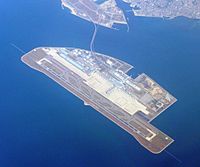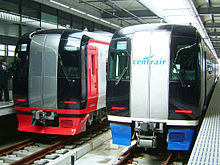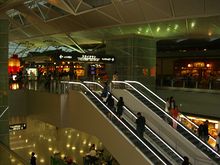- Chūbu Centrair International Airport
-
Chūbu Centrair International Airport
中部国際空港
Chūbu Kokusai Kūkō
IATA: NGO – ICAO: RJGG Summary Airport type Public Owner/Operator Central Japan International Airport Co., Ltd. (CJIAC) Serves Nagoya, Japan Location Tokoname, Aichi, Japan Hub for Japan Airlines Elevation AMSL 12 ft / 4 m Coordinates 34°51′30″N 136°48′19″E / 34.85833°N 136.80528°ECoordinates: 34°51′30″N 136°48′19″E / 34.85833°N 136.80528°E Website Map Location in Japan 34°51′30″N 136°48′19″E / 34.85833°N 136.80528°E Runways Direction Length Surface m ft 18/36 3,500 11,483 Concrete/Asphalt Source: Japanese AIP at AIS Japan[1] Chūbu Centrair International Airport (中部国際空港 Chūbu Kokusai Kūkō) (IATA: NGO, ICAO: RJGG) is an airport on an artificial island in Ise Bay, Tokoname City in Aichi Prefecture, 35 km (22 mi) south[1] of Nagoya in central Japan.
Centrair is classified as a first class airport and is the main international gateway for the Chūbu ("central") region of Japan. The name "Centrair" (セントレア Sentorea) is an abbreviation of Central Japan International Airport, an alternate translation used in the English name of the airport's operating company, Central Japan International Airport Co., Ltd. (中部国際空港株式会社 Chūbu Kokusai Kūkō Kabushiki-gaisha).
Some 11,721,673 people used the airport in the 2006, ranking 8th busiest in the nation. 273,874 tons of cargo was moved in 2005.
For the fiscal year ending in March 2009, the above figures have dropped considerably to 10.8 million passengers. Combined international and domestic cargo figures totaled just 162,000 tons for the same year, a dramatic drop that can be largely blamed on the substantially weakened manufacturing economy since the fall of 2008 in the Aichi region.[2]
Contents
History
Chūbu is Japan's third off-shore airport, after Nagasaki Airport and Kansai International Airport, and is also the second airport built in Japan on a manmade island. There are currently 5 offshore airports in Japan, including Kobe Airport and Kitakyushu Airport.
With much lobbying by local business groups such as Toyota, especially for 24 hour cargo flights, construction started August 2000, with a budget of JPY¥768 billion (€5.5 billion, US$7.3 billion), but through efficient management nearly ¥100 billion was saved.[3] PentaOcean Construction was a major contractor.
In addition to cost cutting measures, a number of environmental protection measures had been taken after learning from Kansai International Airport. The artificial island itself was shaped like the rounded letter "D" so that sea currents inside the bay will flow freely. Its shores were partially constructed with natural rocks and sloped to aid sea lifeforms to set up colonies. During the construction a species of Little Tern occasionally came, so a part of it was selected and set aside to aid nesting.
When the airport opened on February 17, 2005, it took over almost all of the existing Nagoya Airport (now Nagoya Airfield)'s commercial flights, and relieved Tokyo and Kansai areas of cargo shipments. As a replacement for Nagoya Airport, it also inherited its IATA airport code NGO. The airport's opening anticipated the Expo 2005 in Aichi Prefecture. The airport is speculated to have some competition with Shizuoka Airport, which opened on June 4, 2009.
Japan Airlines (JAL) was the first airline to land an aircraft at Centrair: A Boeing 767-300ER, carrying around 206 passengers on board a charter flight from Saipan to commemorate the opening of Centrair.[4]
Future
The airport has undertaken airport ramp expansion in 7 locations starting in 2006, scheduled to be done in 2010. A second 4,000 m (13,000 ft) runway is planned, adding an extra 3 km2 (1.2 sq mi) of area, 300 m (980 ft) from the existing runway. This project is scheduled to be funded in 2008, costing ¥2 trillion.
There is considerable debate about the need for a second runway given reductions in both passenger numbers and aircraft movements in the last two years.
Main terminal
The main terminal is shaped like a "T," with three piers radiating from a central ticketing area. This design keeps check-in distances below 300 m (980 ft). Originally, designers planned to make the main terminal resemble an origami crane from above, but this plan was abandoned due to cost.
The northern side of the terminal holds domestic flights, while the southern side holds international flights, each with dedicated ticket counters, security checkpoints and baggage carousels, and for international flights, immigration and customs facilities.
Arrivals are processed on the second floor, and departures on the third. The lower level is used for maintenance, catering, and other ground operations, as well as for passenger buses to hardstands in the middle of the airport ramp.
Airlines and destinations
Passenger
Airlines Destinations Air China Beijing-Capital, Chengdu, Shanghai-Pudong All Nippon Airways Hong Kong, Miyazaki, Nagasaki, Naha, Sapporo-Chitose, Seoul-Incheon
Sesaonal: Shanghai-PudongANA operated by Air Central Akita, Fukuoka, Matsuyama, Niigata, Sendai, Tokushima, Tokyo-Narita, Yonago, Hakodate Asiana Airlines Seoul-Incheon Cathay Pacific Hong Kong, Taipei-Taoyuan China Airlines Kaohsiung, Taipei-Taoyuan China Eastern Airlines Beijing-Capital, Nanjing, Qingdao, Shanghai-Pudong, Xi'an China Southern Airlines Changchun, Dalian, Guangzhou, Shanghai-Pudong, Shenyang Continental Airlines Guam Delta Air Lines Detroit, Guam, Manila
Seasonal: Honolulu, SaipanEtihad Airways Abu Dhabi, Beijing-Capital EVA Air Taipei-Taoyuan Finnair Helsinki Fly Micronesia operated by Sky King, Inc. Saipan Garuda Indonesia Denpasar/Bali Ibex Airlines Oita Japan Airlines Aomori, Honolulu, Naha, Sapporo-Chitose, Shanghai-Pudong, Taipei-Taoyuan, Tianjin Japan Airlines operated by JAL Express Kagoshima, Sendai, Tokyo-Narita Japan Airlines operated by Japan Transocean Air Ishigaki Jeju Air Seoul-Gimpo Korean Air Busan, Jeju, Seoul-Incheon Lufthansa Frankfurt Philippine Airlines Manila Singapore Airlines Singapore Skymark Airlines Ibaraki, Sapporo-Chitose, Tokyo-Haneda Thai Airways International Bangkok-Suvarnabhumi Vietnam Airlines Hanoi, Ho Chi Minh City Scheduled cargo airlines and destinations
- AirBridgeCargo Airlines
- Air Hong Kong
- Asiana Cargo
- Atlas Air/Boeing
- DHL Express
- Kalitta Air (Anchorage, Chicago-O'Hare, Newark)
- Korean Air Cargo
- Nippon Cargo Airlines
- UPS Airlines
Access
Train
Central Japan International Airport Station, the train station for Centrair is located on the Meitetsu Airport Line operated by Nagoya Railroad (Meitetsu). The fastest "μSky Limited Express" service connects the airport to Meitetsu-Nagoya Station in 28 minutes. Meitetsu Nagoya is adjacent to JR Nagoya Station, allowing transfers to Shinkansen high-speed trains bound for Kyoto and Shizuoka, as well as JR, Meitetsu, and Kintetsu local trains, and the Nagoya Municipal Subway.
Bus
Scheduled bus service is available to a number of locations throughout central Japan.
Ferry
Three high-speed ferry services link Centrair to the west side of Ise Bay. One ferry connects to the passenger terminal in Tsu - a 40-minute trip. Another ferry links Matsusaka to Tokoname, taking 45 minutes.
Car
A toll road links Centrair and the mainland.
Shopping
Centrair features the 4th Floor Sky Town shopping center, accessible to the general public, with 61 shops and restaurants. organized into two "streets," Renga-dori[5] and Chochin-yokocho.[6] The Chochin-yokocho shops are individually themed to have an authentic Japanese look.
There is a duty-free[7] area in the international departure area on the 3rd floor as well.
References
External links
- Official website
- Chubu Centrair International Airport travel guide from Wikitravel
- Japan Mint: The Opening of CHUBU CENTRAIR International Airport 500 Yen Commemorative Silver Proof Coin
- Current weather for RJGG at NOAA/NWS
- Accident history for NGO at Aviation Safety Network
Japanese airports First class airports Chūbu Centrair International · Kansai International · Narita International · Osaka International (Itami) · Tokyo International (Haneda)Second class airports Third class airports Aguni · Amami · Aomori · Fukue · Fukui · Fukushima · Hachijojima · Hanamaki · Hateruma · Ibaraki (Hyakuri) · Iejima · Iki · New Ishigaki · Ishigaki · Iwami · Izumo · Kamigoto · Kerama · Kikai · Kitadaito · Kobe · Kōzushima · Kumejima · Matsumoto · Memanbetsu · Minami-Daito · Miyakejima · Miyako · Monbetsu · Nakashibetsu · Nanki-Shirahama · New Tanegashima · Niijima · Noto · Odate-Noshiro · Ojika · Okayama · Oki · Okinoerabu · Okushiri · Oshima · Rebun · Rishiri · Sado · Saga · Shimojishima · Shizuoka · Shonai · Tarama · Tokunoshima · Tottori · Toyama · Tsushima · Yakushima · Yonaguni · YoronOther airports Amakusa · Chofu · Hiroshima-Nishi · Honda · Kasaoka · Kōnan · Komatsu* · Makurazaki · Miho-Yonago* · Misawa Air Base/Misawa Airport* · Nagoya · Oitakenou · Okadama* · Tajima · Teshikaga · Tokushima*
(*: dual military/civilian use)Military only airfields Akeno · Asahikawa · Ashiya · Atsugi · Chitose · Futenma · Gifu · Hachinohe · Hamamatsu · Hōfu · Hyakuri · Iruma · Iwakuni · Kanoya · Matsushima · Metabaru · Iwo Jima · Kadena · Kasumigaura · Kasuminome · Kisarazu · Minami Torishima · Nyutabaru · Ōminato · Ozuki · Shimofusa · Shizuhama · Tachikawa · Tateyama · Tokachi · Tsuiki · Utsunomiya · YokotaHeliports Defunct airports Categories:- Artificial island airports
- Artificial islands of Japan
- Buildings and structures in Aichi Prefecture
- Visitor attractions in Aichi Prefecture
- Airports in Japan
- Economy of Nagoya
- Transport in Nagoya
Wikimedia Foundation. 2010.







